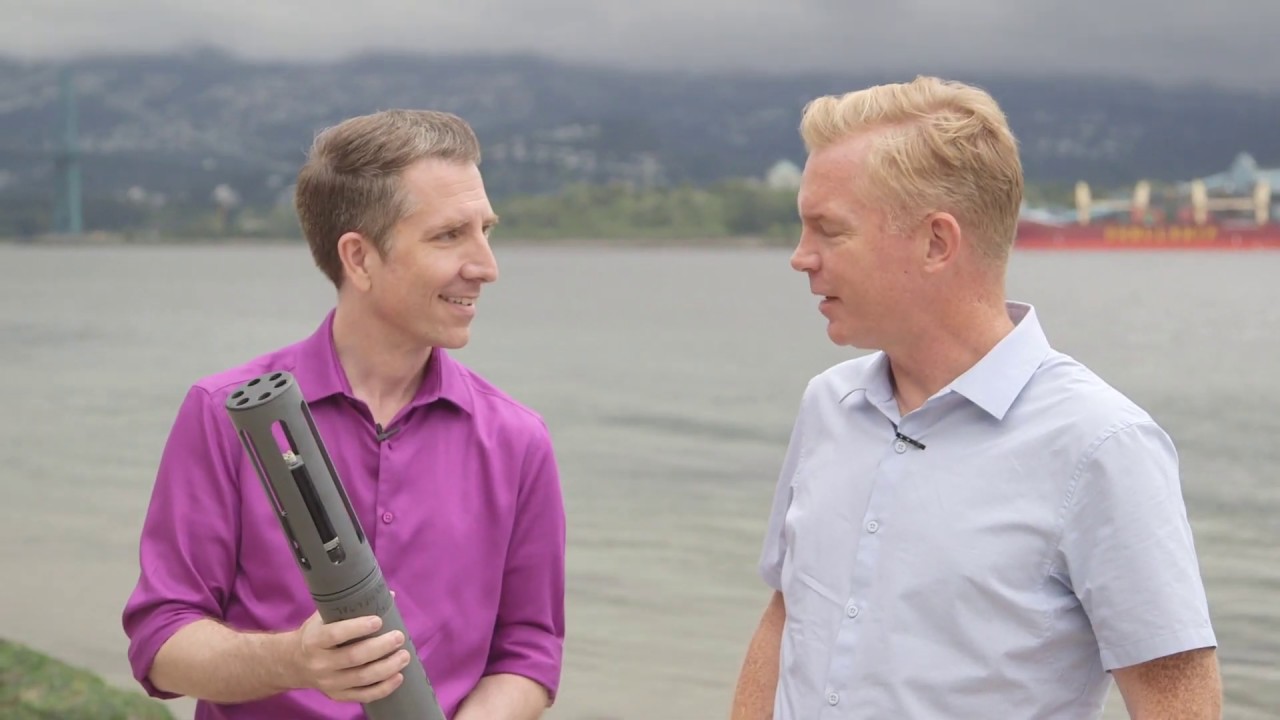[Dramatic music. Ed Quilty examining a flask of beach water]
>> Michael Hainsworth (voiceover): This man is an environmental superhero.
[Arial view of a village next to a river in Malaysia]
He's helped save a village in Malaysia from floods.
[Quick shots of a beach, the Toronto skyline at night and a dragon statue in Stanley Park. Arial view of a river in British Columbia]
Waded through poisoned waters in the B.C. interior.
[Quick shots of the Lions Gate Bridge from Stanley Park, Michael and Ed standing on a beach talking, and the Toronto skyline at night]
And braved the financial wilderness of Bay Street.
[Ed sitting in his office. Music stops]
>> Ed: Hi, I'm Ed Quilty, President and CEO of Aquatic Informatics.
[Funky music. Ed showing Michael the water sensor on the beach at Stanley Park. Close-up of the water sensor. The water sensor laying on a table next to some books. The Lions Gate Bridge]
>> Michael (voiceover): How did this mild mannered entrepreneur flex his clean tech data analytics super powers in 60 countries around the world?
[Michael throwing the water sensor into the water]
How do you expand into global markets?
[CIBC logo. Innovation banking. #cibcinnovationeconomy]
[Quick shots of the end of the water sensor, 2 office workers using their computers, Ed examining a flask of beach water, Ed and Michael walking on the beach holding the water sensor and Michael and Ed standing on the beach talking]
I'm Michael Hainsworth, discovering the secrets to success in the innovation economy.
[0:37][How do you expand into global markets?]
[Ed and Michael standing on the beach in Stanley Park and holding a water sensor]
>> Ed: 80% of the pollution coming out of industry and sewage from human waste goes back into the environment untreated. I thought this was a mission that I had to do. Historically, if you wanted to see what's happening with water you would take a sample in a bottle and send it to a lab.
[Ed examining a flask of beach water. A flask of water sitting in a lab. Ed examining a flask of water in a lab]
It'd maybe come back a week later, a month later or...
[Michael and Ed examining a water sensor on the beach]
These sensors came out in the early 90s where you could basically take that sensitive equipment they have in labs and put it actually in the river, ah, or in the lake or in the groundwater. And they measure continuously.
[Still image of a river transforms into a video of the river water rushing by. Sound of film running through a projector. Michael and Ed talking on the beach]
It's like the difference in looking at a photo versus watching the whole movie. I was like, this is gonna change everything.
[Dramatic music. Ed examining a flask of water. Ed and Michael standing at the edge of the beach. Ed examining a flask of water in a lab. Michael taking the protective guard off of the sensor and exposing the different parts of the sensor. Michael throwing the sensor into water]
[1:07]>> Michael (voiceover): And so a superhero CEO was born. Intent on saving lives by analyzing that tsunami of data, to ensure the world has clean water. And by redirecting rising rivers before flooding can occur.
[Ed walking into his office. Employees working at their computers. Ed sitting in his office]
But the ability to leap tall startup hurdles in a single bound was not something Quilty learned overnight.
[Ed and Michael talking on the beach]
>> Ed: Yeah, it was not an easy journey. First, I didn't really have the right skillset.
[Office workers at their computers]
I didn't know about financials and HR policy. So I went back and started learning business, basically.
[Ed and Michael talking on the beach. Ed speaking to his employees and giving Michael a tour of his office]
I went to MIT and took entrepreneurial master’s program. I took a bootcamp for business.
[Ed and Michael talking on the beach]
>> Michael: Do you miss not wading out there into the waters, anymore?
>> Ed: No, I don't miss it all. I didn't feel I was making uh, you know a big enough impact and I wanted to work on much larger problems.
[Ed giving Michael a tour of his office. Ed sitting in his office]
>> Michael (voiceover): Would you advise an entrepreneur to go global as quickly as possible?
>> Ed: Probably not.
[Record scratch. Dramatic music stops]
[1:59][Ed Quilty's 3 steps to going global]
[Funky bass and drum music. Workers typing on a computer. Ed and Michael entering an office. River flowing between rocks somewhere in the United States]
>> Michael (voiceover): For Quilty's Aquatic Informatics to work on much larger problems, his first step was to expand into his nearest neighbour, the United States.
[Ed sitting in his office]
>> Ed: We really wanted to move globally, because water is a global problem. Getting out of Canada, uh, I think for many companies can be very hard. We actually, uh, started out mostly in the U.S., that's where we had the earliest success and the biggest success.
[2:16][#1 Extend your reach into regions that speak your language]
[Ed and Michael walking along the beach towards the water. Ed has a water sensor in his hands. Ed and Michael standing at the edge of the water.]
>> Michael (voiceover): And it was that first win that helped Quilty overcome that biggest pain point in going global: building your reputation.
[Ed sitting in his office]
>> Ed: A reputation is really important. The clean tech market's a really challenging market to get into. At the core of it, it's very conservative. And they can't really afford to take big bets. We got our start really selling to people that trusted me.
[Ed examining a flask of beach water. Ed laughing outside. Ed walking with Michael on the Stanley Park beach. Ed talking to Michael while they walk through the Aquatic Informatics office]
>> Michael (voiceover): Quilty first leveraged the contract and the cachet of working with the biggest player in the world, into contracts within the company's comfort zone.
[Ed sitting in his office]
>> Ed: So our approach was really to start with Commonwealth countries.
[Globe with Australia labelled, outlined in red and marked with an Aquatic Informatics logo. The globe turns as New Zealand, England and the United States of America are similarly labelled and highlighted]
So we sold into Australia, New Zealand, England, of course U.S., uh, as well.
[Close up of the tide washing over the edge of the beach. Ed examining a flask of water in a lab. Ed standing on the beach and looking off into the distance]
>> Michael (voiceover): But after helping save the western world's water, Quilty turned his steely gaze further afield.
[The globe turns as Thailand, Indonesia, Brazil and Argentina are labelled, outlined in red and marked with an Aquatic Informatics logo]
>> Ed: Thailand, Indonesia, Brazil, Argentina.
[Ed sitting in his office]
>> Ed: So, I had a certain amount of comfort in interacting with those countries and cultures.
[3:07][#2 Leverage local partners in unfamiliar markets]
Rather than building up a relationship which can take years or decades like we've done in North America, we've leveraged partners.
[The globe turns as Thailand, Malaysia, Sri Lanka, Afghanistan and Colombia are labelled, outlined in red and marked with an Aquatic Informatics logo]
We’re in Malaysia, we're in Sri Lanka, we're in Afghanistan, we're in Colombia.
[Ed sitting in his office]
All these areas we've really had to find partners that work with our, our end market there.
[Michael and Ed walking on the beach. The Lions Gate Bridge. A factory on the water. A dragon statue in Stanley Park]
>> Michael (voiceover): And for Quilty, when it came time to acquire those partners, growth through acquisition required a different kind of partner. One that understood the innovation economy.
[3:30][#3 Grow through acquisition with the right financing partner]
[Ed sitting in his office]
>> Ed: Unlike a lot of other banks we had, uh, worked with directly in Canada, uh, CIBC was quite open to work with entrepreneurs. CIBC had this innovative DNA in them. They provided a flexible financing platform that, uh, really helped us with our strategy which was to use debt financing, which is non-dilutive. And it could be a much lower cost of money. We're acquiring companies and we've acquired 3 companies in the last 2 years.
[Michael and Ed standing on the beach near the water]
[3:58]>> Michael: Did you bring your hip waders?
>> Ed: I did not bring them today. In fact, I donated them to the University of British Columbia. I'm confident I won't need 'em again.
[Laughing]
[Presented by. CIBC logo. The CIBC Logo is a trademark of CIBC]







